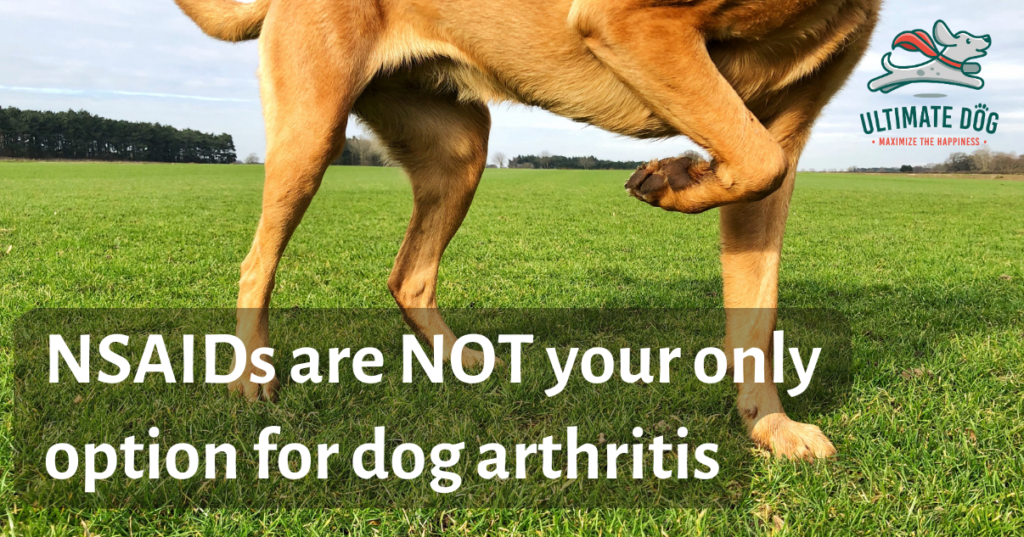Arthritis is a painful joint disease that significantly lowers the canine quality of life as it inhibits one of the things our dogs need the most — movement. Unfortunately, canine arthritis is a life-long condition, so all treatment options need to be safe long-term. Traditional treatment focuses on numbing arthritic pain with heavy medication, predominantly various non-steroidal anti-inflammatory drugs (NSAIDs).
Corticosteroids, gabapentin, opioids, and other pain medication might also get prescribed, sometimes in combination with NSAIDs. This article explores the lack of reliable information about NSAIDs and introduces well-researched alternative treatments that not only reduce the pain but support mobility and regeneration of the joints as well.
Causes & Risk Factors of Canine Arthritis
Osteoarthritis, also known as degenerative joint disease, is the most common type of arthritis in dogs. It’s often caused by the natural wear-and-tear of the joint that comes with years, which is why it impacts the majority of senior dogs. Other common causes of osteoarthritis are improper nutrition, injury, abnormal development, and obesity.
A less common (though possible) type of dog arthritis is rheumatoid arthritis, also called inflammatory joint disease. Caused by an autoimmune response, the dog’s overactive immune system attacks multiple joints in the body at the same time. It can also be caused by Lyme disease, carried by ticks.
Aging and breed are the main risk factors for canine arthritis — as mentioned, osteoarthritis is common in senior dogs and very prevalent in large breeds.But this doesn’t mean younger dogs and small breeds can’t get arthritis! Risk factors beyond age and breed are: genetics, incorrect breeding practices, weight, a diet without proper nutrients, the intensity of exercise in the first year of the dog’s life, and even being neutered/spayed.
Arthritis is a life-long condition that is mostly irreversible. It happens when the healthy structure of the joint begins to deteriorate, leading to severely impaired functioning. This deterioration is often a painless process until it’s too late. By the time any clinical signs of osteoarthritis are noticeable, the joint is already irreversibly damaged. Arthritic dogs are constantly dealing with inflammation and pain, so all dog owners should be aware of the symptoms and notice them as early as possible.
Symptoms of Arthritis in Dogs
The symptoms of your dog’s arthritis can be connected to pain, movement, or both. Here are some signs your dog might be suffering from arthritis:
- Flinching when touched or avoiding your touch
- Not walking correctly — stiffness, lameness, limping
- Difficulty walking up and down the stairs
- Difficulty jumping on and off higher surfaces, such as the couch
- Difficulty standing up and lying down
- Very slow walking or whining while walking
- Stopping on walks and refusing to go further
- Enlarged joints
- Excessively grooming their joints
- Sudden onset of aggression, especially when touched
Arthritis Medication for Dogs — Fascinating Study Shows Why Owners Don’t Know the Risks
NSAIDs are the first choice of treatment for arthritis in many veterinary clinics. The risks of these drugs are well-documented but unfortunately not well-known. Gastrointestinal damage is the most commonly observed adverse effect, with dog owners reporting internal bleeding in the dog’s GI tract, episodes of bloody diarrhea and bloody vomiting, intestinal ruptures, ulcerations, and more. Another risk of NSAIDs is toxicity to the kidneys and the liver. They can also cause diarrhea, depression, loss of appetite, and even degeneration of the joint with prolonged use.
In clinical veterinary practice, when adverse effects appear, veterinarians choose one of the four options:
- Treating the symptoms with additional medication.
- Taking the dog off the NSAID for a short time and then prescribing a different type of NSAID.
- Taking the dog off the NSAID for a short time and then prescribing the same NSAID!
- Switching the dog’s medication to a different analgesic (opioids, corticosteroids, gabapentin, etc.)
In 2014, a UK study investigated the opinions on long-term NSAID use by dog owners and veterinary professionals, specifically in the case of canine osteoarthritis. Researchers interviewed 40 dog owners whose dogs had been given NSAID treatment for arthritis at some point. Additionally, five focus groups were held with 31 veterinary professionals — four with veterinarians and one with veterinary nurses.
The survey revealed that all groups had a high level of concern about the long-term use of NSAIDs in dogs. Dog owners struggled to get accurate and reliable information from veterinary professionals about the risks of the medication. Some weren’t told about the risks at all!
Many felt that the information they did receive wasn’t complete, as they were never provided with the drug manufacturer’s package insert or any other type of written information. They had to turn to the internet to learn more about the drug prescribed to their dog. (On this note, almost all drugs have the package insert available online. Find them by searching “the drug’s branded name + package insert” and read what it says before consenting to any medication).
The information found on the internet alarmed some dog owners, but ultimately they consented to the drug because they trusted their veterinarian more than the internet. This highlights another interesting finding: most dog owners were willing to take on the risks UNLESS they’ve had a family member or a friend whose dog reacted to that same drug! There’s a common belief that some NSAIDs are less dangerous than others.
Carprofen, sold under the brand name Rimadyl, is one of them. And yet, one dog owner in the study described: “I’m absolutely anti Rimadyl. It’s on my notes that never, ever give my dogs Rimadyl. And then when I find they’ve had Rimadyl I go mad. My parents’ cocker spaniel died of platelet eruption on Rimadyl, at seven … It might be good pain relief but I will not have it.” If it doesn’t hit close to home, it’s easy to overlook the risks as something that only happens to “other people.” But what about veterinarians? Surely they see many dogs affected?
ALL veterinary professionals included in this study were well aware of the potential risks of NSAID use, especially of the more life-threatening risks, such as kidney and liver toxicity and gastrointestinal ulceration. Still, they expressed their frustration at being unable to persuade owners to use NSAIDs for their dog’s arthritis.
Some vets that didn’t tell the owners about adverse effects assumed they were already aware of them. Both veterinarians and veterinary nurses reported that they often didn’t have enough time to have a longer discussion with the owners, especially if they diagnosed osteoarthritis in a consultation for a separate issue. We have to start a conversation about informed consent in veterinary practice!
Dog owners can live to regret their decisions when they’re not given the full picture! Veterinary clinics need to prioritize informing the owners about adverse effects above all else. This, of course, only works if veterinary professionals recognize adverse effects in the first place.
Veterinary nurses generally recognized more adverse effects than veterinarians, but even among veterinarians, there was disagreement on how frequently these side effects occur. A lot of veterinarians didn’t recognize certain symptoms as “true adverse events,” suggesting that they might have been caused by “something else.”
Adverse effects that were recognized were commonly assigned to the owners’ mistakes in dosing. This is a very irresponsible claim on the veterinarians’ part, considering the majority of them later confessed that, even though they think lower doses of NSAIDs would be better, they are not sure about when or how to reduce the dose, if at all. They also disclosed being uncertain about which NSAID to prescribe.
So … the veterinarians are unsure about safe dosing, the owners are asked to dose their dogs with a drug they are severely uninformed about, the drug is given to them without the box or its package insert (where the correct dosing & adverse reactions might be noted!), and when the adverse reaction happens, the owners get told it was their own fault because they administered the drug “in the wrong way.” Needless to say, reporting adverse effects to the UK’s Veterinary Medicine Directorate was found to be uncommon.
Science-Backed Natural Remedies for Dog Arthritis
When looking for a natural alternative to medication, owners of arthritic dogs are searching for joint supplements that are anti-inflammatory, safe to use long-term, alleviate the dog’s pain, slow down joint deterioration, and promote healing and regeneration. We’ve already written about how turmeric can help arthritic dogs and how CBD oil is one of the best natural pain reliefs, especially for arthritic pain.
Other popular supplements that are considered safe for dogs and can reduce arthritic pain are alfalfa, yucca, and MSM. They all have proven anti-inflammatory properties! Hopefully, future studies on canine arthritis can show us the full effect of these supplements on joint disease.
There are two supplements, however, that are significantly praised in the scientific literature for their incredible performance in dog arthritis studies, so let’s take a closer look at them.
Green-Lipped Mussel (Perna Canaliculus)
Full of joint-supporting nutrients (chondroitin sulfates, omega-3, amino acids, vitamins E and C, manganese, zinc, and copper), the green-lipped mussel is a powerhouse that easily rivals and surpasses arthritic medication. In sharp contrast to NSAIDs, the green-lipped mussel is non-toxic and has gastroprotective effects!
Some studies suggest it can help heal GI damage previously caused by NSAIDs. When buying this supplement, choose a product made with low-temperature processing because green-lipped mussel loses its potency when processed at high temperatures.
A series of studies compared the effects of green-lipped mussel in three different forms on canine arthritis. They looked at a freeze-dried powder supplement, a dog treat, and dry kibble. In all three studies, green-lipped mussel significantly improved the dogs’ arthritic pain and joint swelling within 6 weeks. The biggest improvements were seen when using the powder supplement — 83% of dogs included in that study showed a 30-70% improvement in their arthritis symptoms!
Researchers speculate that a long-term supplementation of a freeze-dried powder supplement could stop the degeneration of the joint and help with its regeneration, possibly reversing some of the damage. Be aware, however, that this supplement is not safe for dogs with shellfish allergy or intolerance!
The Combination of Glucosamine + Chondroitin Sulfate
Glucosamine and chondroitin sulfate have both been studied for their potential to naturally treat osteoarthritis. They’re found in cartilage, a crucial and protective tissue in the joints that prevents the bones from rubbing against each other. When cartilage deteriorates in arthritic dogs, the rubbing bones create friction that causes a lot of pain.
While both glucosamine and chondroitin sulfate have been looked at individually for their protective effects in osteoarthritis, studies show that their greatest effect is reached when they’re given in combination. Quality joint supplements for dogs should have both listed under ingredients. The most important thing to remember when supplementing with this combination is that it can take 2-3 months before the dog's condition begins to improve.
One study examined this combination in comparison to the NSAID carprofen in dogs with osteoarthritis. The results showed that the glucosamine + chondroitin sulfate combination wasn’t inferior to carprofen treatment, as it significantly improved the dogs’ overall condition, especially pain and weight-bearing. But the first results weren’t visible until day 70, so be patient & consistent with this supplement combination.
Natural Treatments Beyond Dietary Supplements
Dietary supplements are a great way to support your dog’s healing from the inside out, but if your dog needs more support, there are other non-invasive treatments for arthritis. They’re done by holistic professionals who can provide regular advice, support, and guidance often unavailable in clinical settings. Alternative holistic treatments recommended for dog arthritis are:
- Fresh food diet
- Homeopathy: A study of 68 dogs diagnosed with osteoarthritis compared homeopathic preparation Zeel with carprofen over 56 days. Zeel proved to be just as effective as carprofen and was also tolerated better.
- Acupuncture: Helps with pain relief, even in the case of rheumatoid arthritis.
- Physical therapy
- Cold (low-level) laser therapy: Promotes cell regeneration and bone healing.
Dog arthritis may be a life-long condition but it doesn’t have to permanently lower the quality of a dog's life and your mutual life together. Natural remedies for canine arthritis are widely available and generally cost less than life-long pain medication. Our approach to treating dog arthritis should focus on more than just pain relief!
The treatment needs to also support the health, regeneration, and mobility of the dog’s joints. Though it may at first seem daunting to refuse long-term pain medication, you are your dog’s advocate and the final call has always been yours. Trust your gut.
Sources
Llera, Ryan. Downing, Robin. “Arthritis in Dogs.” VCA Animal Hospitals.
Belshaw, Zoe. Asher, Lucy. Dean, S. Rachel. “The attitudes of owners and veterinary professionals in the United Kingdom to the risk of adverse events associated with using non-steroidal anti-inflammatory drugs (NSAIDs) to treat dogs with osteoarthritis.” PMC, 01/09/2016.
Bierer, Tiffany Linn. Bui, M. Linh. “Improvement of Arthritic Signs in Dogs Fed Green-Lipped Mussel (Perna canaliculus).” Oxford Academic, 01/06/2002.
McCarthy, Grainne. O’Donovan, James. Jones, Boyd. McAllister, Hester. Seed, Michael. Mooney, Carmel. “Randomised double-blind, positive-controlled trial to assess the efficacy of glucosamine/chondroitin sulfate for the treatment of dogs with osteoarthritis.” Science Direct, 07/2007.
Neumann, Stephan. Stolt, Pelle. Braun, Gabriele. Hellmann, Klaus. Reinhart, Erich. “Effectiveness of the Homeopathic Preparation Zeel Compared with Carprofen in Dogs with Osteoarthritis.” JAAHA, 01/01/2011.

Luna’s passion for learning about canine psychology and behavior began when she adopted a severely reactive puppy from a local shelter. She is now a big advocate for positive reinforcement and compassionate training. As a writer, she strives to spotlight the topics that fly under the radar and be the voice for all who cannot speak for themselves.














I don’t think most pet owners are educated with the bad side effects associated with rymadol. I did not want to give it to my baby and my vet told me there was nothing else I could do.
Fortunately, I discovered Andrew Jones, veterinarian
With his YouTube channel.
There are alternatives and simple herbs some combinations have through studies shown to be as effective as rymadol for pain in our pets.
Same on our veterinarians.
THANK YOU for your thorough and honest research!
Thank you, Barbara! My 11 year old dog has recently been showing signs of pain and i’ve been looking for help and answers. 🙂